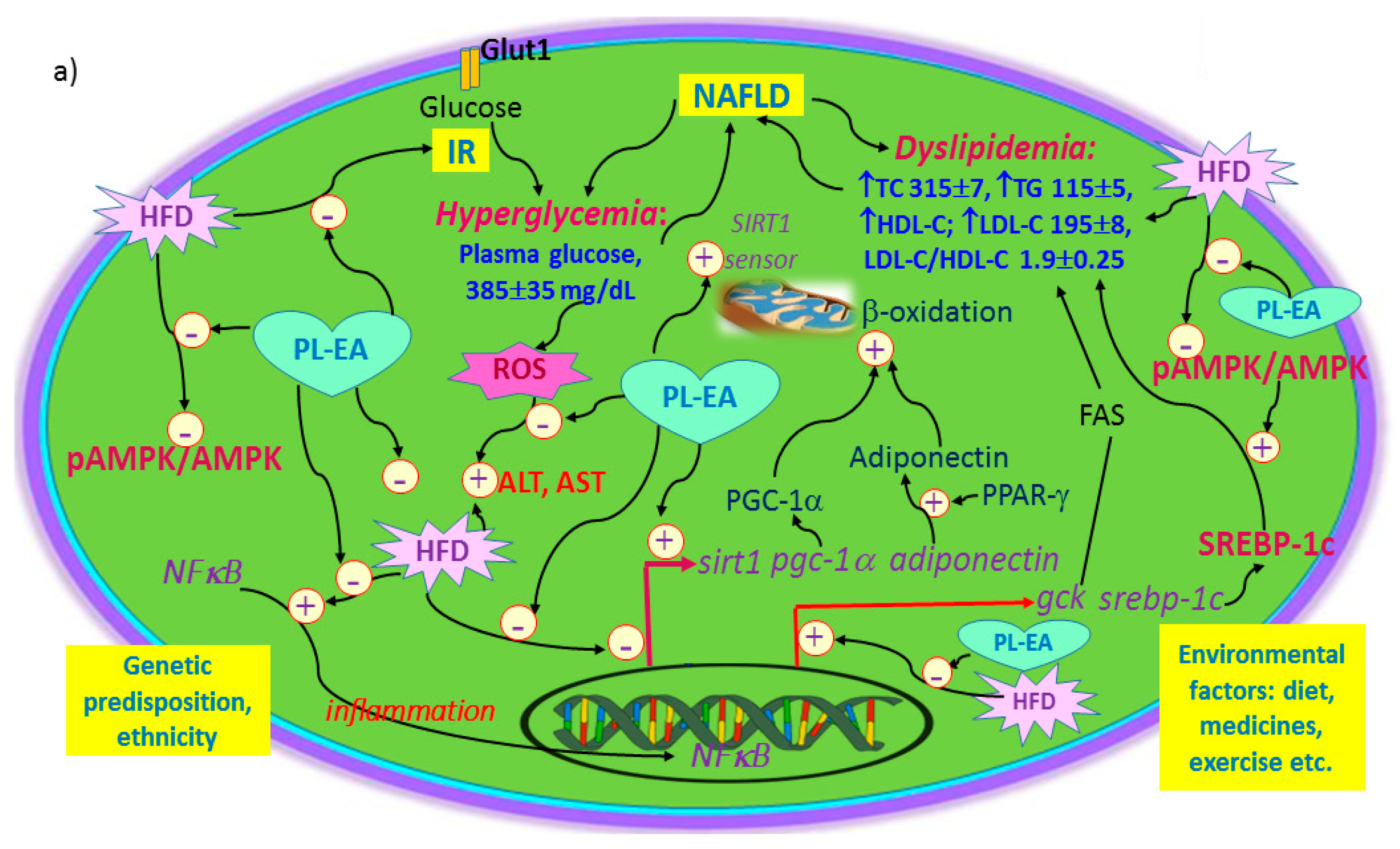Styrylpyrones from Phellinus linteus Mycelia Alleviate Non-Alcoholic Fatty Liver by Modulating Lipid and Glucose Metabolic Homeostasis in High-Fat and High-Fructose Diet-Fed Mice
Abstract
:1. Introduction
2. Materials and Methods
2.1. Chemicals and Equipments
2.2. Cultivation of P. linteus Mycelia
2.3. Preparation of P. linteus Mycelial Extract
2.4. Solvent Partition of PL
2.5. Purification of PL-EA with Centrifugal Partition Chromatography
2.6. HPLC and HPLC/ESI-MS-MS Analyses of PL-EA Extract
2.7. Animal Experiment
2.8. Oral Glucose Tolerance Test (OGTT)
2.9. Biochemical Measurements for Blood
2.10. Histological Examination
2.11. Hematoxylin-Eosin Staining
2.12. Oil-Red O Staining
2.13. Protein Extraction and Western Blot Analysis
2.14. RNA Isolation and Quantitative Real-Time PCR (qPCR)
2.15. HepG2 Cells Experiments
2.16. Fatty Acid Induced Mimic Hepatosteatosis in HepG2 Cells and the Treatment of Purified Compounds
2.17. Analysis for Gene Expression in HepG2 Cells
2.18. Statistical Analysis
3. Results and Discussion
3.1. Yield of Extraction from Different Solvent and the Solvent Partition
3.2. Evaluation of the Distribution Coefficient (Kd) for CPC
3.3. Identification and Quantification of Constituents of PL-EA by HPLC-ESI-MS/MS
3.4. The Antioxidative Capability
3.4.1. DPPH Radical Scavenging Capability
3.4.2. ABTS+ Radical Scavenging Capability
3.5. Body Weight Variation of Experimental Mice
3.6. The Ratio of Liver to Body Weight
3.7. Plasma Biochemical Measurements
3.7.1. The Total Plasma Cholesterol Level
3.7.2. The Plasma HDL-C Level
3.7.3. The Plasma LDL-C Level
3.7.4. Ratio of HDL-C/LDL-C
3.7.5. The Plasma Triglyceride Levels
3.7.6. Plasma Level of GOT and GPT
3.8. Oral Glucose Tolerance Test
3.9. HE Staining and Oil-Red Staining of Mice Liver Tissues
3.10. Effects of Purified Compounds from PL-EA on Free Fatty Acids-Induced Steatosis in HepG2 Cells
3.11. Relative Gene Expression in Mice Liver Tissues
3.12. Relative Gene Expression in HepG2 Cells
3.13. Western Blotting
4. Conclusions
Supplementary Materials
Author Contributions
Funding
Institutional Review Board Statement
Informed Consent Statement
Data Availability Statement
Acknowledgments
Conflicts of Interest
References
- Younossi, Z.; Anstee, Q.M.; Marietti, M.; Hardy, T.; Henry, L.; Eslam, M.; George, J.; Bugianesi, E. Global burden of NAFLD and NASH: Trends, predictions, risk factors and prevention. Nat. Rev. Gastroenterol. Hepatol. 2018, 15, 11–20. [Google Scholar] [CrossRef]
- Younossi, Z.M.; Koenig, A.B.; Abdelatif, D.; Fazel, Y.; Henry, L.; Wymer, M. Global epidemiology of nonalcoholic fatty liver disease—Meta-analytic assessment of prevalence, incidence, and outcomes. Hepatology 2016, 64, 73–84. [Google Scholar] [CrossRef] [Green Version]
- Chen, C.-H.; Huang, M.-H.; Yang, J.-C.; Nien, C.-K.; Yang, C.-C. Prevalence and risk factors of nonalcoholic fatty liver disease in an adult population of Taiwan: Metabolic significance of nonalcoholic fatty liver disease in nonobese adults. J. Clin. Gastroenterol. 2006, 40, 745–752. [Google Scholar] [CrossRef]
- Zhang, Q.-Q.; Lu, L.-G. Nonalcoholic fatty liver disease: Dyslipidemia, risk for cardiovascular complications, and treatment strategy. J. Clin. Transl. Hepatol. 2015, 3, 78–84. [Google Scholar]
- Lazarus, J.V.; Mark, H.E.; Anstee, Q.M.; Arab, J.P.; Batterham, R.L.; Castera, L.; Cortez-Pinto, H.; Crespo, J.; Cusi, K.; Dirac, M.A.; et al. NAFLD Consensus Consortium. Advancing the global public health agenda for NAFLD: A consensus statement. Nat. Rev. Gastroenterol. Hepatol. 2022, 19, 60–78. [Google Scholar] [CrossRef]
- Araujo, A.R.; Rosso, N.; Bedogni, G.; Tiribelli, C.; Bellentani, S. Global epidemiology of non-alcoholic fatty liver disease/non-alcoholic steatohepatitis: What we need in the future. Liver Int. 2018, 38, 47–51. [Google Scholar] [CrossRef] [Green Version]
- Kanwal, F.; Kramer, J.R.; Mapakshi, S.; Natarajan, Y.; Chayanupatkul, M.; Richardson, P.A.; Li, L.; Desiderio, R.; Thrift, A.P.; Asch, S.M.; et al. Risk of Hepatocellular cancer in patients with non-alcoholic fatty liver disease. Gastroenterology 2018, 155, 1828–1837. [Google Scholar] [CrossRef] [Green Version]
- Zhu, T.; Kim, S.-H.; Chen, C.Y. A medicinal mushroom: Phellinus linteus. Curr. Med. Chem. 2008, 15, 1330–1335. [Google Scholar] [CrossRef]
- Zhou, L.-W.; Ghobad-Nejhad, M.; Tian, X.-M.; Wang, Y.-F.; Wu, F. Current status of ‘Sanghuang’ as a group of medicinal mushrooms and their perspective in industry development. Food Rev. Int. 2020. [Google Scholar] [CrossRef]
- Lee, I.-K.; Yun, B.-S. Highly oxygenated and unsaturated metabolites providing a diversity of hispidin class antioxidants in the medicinal mushrooms Inonotus and Phellinus. Bioorg. Med. Chem. 2007, 15, 3309–3314. [Google Scholar] [CrossRef]
- Yeom, J.H.; Lee, I.K.; Ki, D.W.; Lee, M.S.; Seok, S.J.; Yun, B.S. Neuraminidase inhibitors from the culture broth of Phellinus linteus. Mycobiology 2012, 40, 142–144. [Google Scholar] [CrossRef] [Green Version]
- Jung, J.Y.; Lee, I.K.; Seok, S.J.; Lee, H.J.; Kim, Y.H.; Yun, B.S. Antioxidant polyphenols from the mycelial culture of the medicinal fungi Inonotus xeranticus and Phellinus linteus. J. Appl. Microbiol. 2008, 104, 1824–1832. [Google Scholar] [CrossRef]
- Singh, S.B.; Jayasuriya, H.; Dewey, R.; Polishook, J.D.; Dombrowski, A.W.; Zink, D.L.; Guan, Z.; Collado, J.; Platas, G.; Pelaez, F.; et al. Isolation, structure, and HIV-1-integrase inhibitory activity of structurally diverse fungal metabolites. J. Ind. Microbiol. Biotechnol. 2003, 30, 721–731. [Google Scholar]
- Park, J.M.; Lee, J.S.; Song, J.E.; Sim, Y.C.; Ha, S.; Hong, E.K. Cytoprotective effect of hispidin against pal-mitate-induced lipotoxicity in C2C12 myotubes. Molecules 2015, 20, 5456–5467. [Google Scholar] [CrossRef]
- Park, I.H.; Jeon, S.Y.; Lee, H.J.; Kim, S.I.; Song, K.S. A beta-secretase (BACE1) inhibitor hispidin from the mycelial cultures of Phellinus linteus. Planta Med. 2004, 70, 143–146. [Google Scholar]
- Liu, Y.; Wang, C.; Li, J.; Mei, Y.; Liang, Y. Hypoglycemic and hypolipidemic effects of Phellinus Linteus mycelial extract from solid-state culture in a rat model of type 2 Diabetes. Nutrients 2019, 11, 296. [Google Scholar] [CrossRef] [Green Version]
- Pouwels, S.; Sakran, N.; Graham, Y.; Leal, A.; Pintar, T.; Yang, W.; Kassir, R.; Singhal, R.; Mahawar, K.; Ramnarain, D. Non-alcoholic fatty liver disease (NAFLD): A review of pathophysiology, clinical management and effects of weight loss. BMC Endocr. Disord. 2022, 22, 63. [Google Scholar] [CrossRef]
- Chen, W.; Tan, H.; Liu, Q.; Zheng, X.; Zhang, H.; Liu, Y.; Xu, L. A review: The bioactivities and pharmacological applications of Phellinus linteus. Molecules 2019, 24, 1888. [Google Scholar] [CrossRef] [Green Version]
- Li, I.C.; Chen, C.C.; Sheu, S.J.; Huang, I.H.; Chen, C.C. Optimized production and safety evaluation of hispidin-enriched Sanghuangporus sanghuang mycelia. Food Sci. Nutr. 2020, 8, 1864–1873. [Google Scholar] [CrossRef] [Green Version]
- Lien, H.M.; Huang, S.H.; Chang, C.H.; Huang, C.L.; Chen, C.C.; Chyau, C.C. Innovative Purification Method of Ovatodiolide from Anisomeles indica to Induce Apoptosis in Human Gastric Cancer Cells. Molecules 2022, 27, 587. [Google Scholar] [CrossRef]
- Chyau, C.C.; Wang, H.F.; Zhang, W.J.; Chen, C.C.; Huang, S.H.; Chang, C.C.; Peng, R.Y. Antrodan alleviates high-Fat and high-fructose diet-induced fatty liver disease in C57BL/6 mice model via AMPK/Sirt1/SREBP-1c/PPARγ pathway. Int. J. Mol. Sci. 2020, 21, 360. [Google Scholar] [CrossRef] [Green Version]
- Cui, A.; Hu, Z.; Han, Y.; Yang, Y.; Li, Y. Optimized Analysis of In Vivo and In Vitro Hepatic Steatosis. J. Vis. Exp. 2017, 121, 55178. [Google Scholar]
- Sun, Y.; Yuan, X.; Zhang, F.; Han, Y.; Chang, X.; Xu, X.; Li, Y.; Gao, X. Berberine ameliorates fatty acid-induced oxidative stress in human hepatoma cells. Sci. Rep. 2017, 7, 11340. [Google Scholar] [CrossRef]
- Chyau, C.C.; Wu, H.L.; Peng, C.C.; Huang, S.H.; Chen, C.C.; Chen, C.H.; Peng, R.Y. Potential Protection Effect of ER Homeostasis of N6-(2-Hydroxyethyl)adenosine Isolated from Cordyceps cicadae in Nonsteroidal Anti-Inflammatory Drug-Stimulated Human Proximal Tubular Cells. Int. J. Mol. Sci. 2021, 22, 1577. [Google Scholar] [CrossRef]
- Bojczuk, M.; Zyzelewicz, D.; Hodurek, P. Centrifugal partition chromatography—A review of recent applications and some classic references. J. Sep. Sci. 2017, 40, 1597–1609. [Google Scholar] [CrossRef]
- Min, G.-J.; Jeong, E.-U.; Yun, B.-S.; Kang, H.-W. Chemical identification and antioxidant activity of phenolic compounds extracted from the fruiting body of ‘Hankyong Sanghwang’, Phellinus linteus KACC 93057P. J. Mushroom 2018, 16, 311–317. [Google Scholar]
- Lee, M.-S.; Hwang, B.S.; Lee, I.-K.; Seo, G.-S.; Yun, B.-S. Chemical constituents of the culture broth of Phellinus linteus and their antioxidant activity. Mycobiology 2015, 43, 43–48. [Google Scholar] [CrossRef] [Green Version]
- Chang, H.-Y.; Ho, Y.-L.; Sheu, M.-J.; Lin, Y.-H.; Tseng, M.-C.; Wu, S.-H.; Huang, G.-J.; Chang, Y.-S. Antioxidant and free radical scavenging activities of Phellinus merrillii extracts. Bot. Stud. 2007, 48, 407–417. [Google Scholar]
- Jang, J.S.; Lee, J.S.; Lee, J.H.; Kwon, D.S.; Lee, K.E.; Lee, S.Y.; Hong, E.K. Hispidin produced from Phellinus linteus protects pancreatic β-cells from damage by hydrogen peroxide. Arch. Pharmacal. Res. 2010, 33, 853–861. [Google Scholar] [CrossRef]
- Lee, I.-K.; Yun, B.S. Styrylpyrone-class compounds from medicinal fungi Phellinus and Inonotus spp., and their medicinal importance. J. Antibiot. 2011, 64, 349–359. [Google Scholar] [CrossRef]
- Park, I.-H.; Chung, S.-K.; Lee, K.-B.; Yoo, Y.-C.; Kim, S.-K.; Kim, G.-S.; Song, K.-S. An antioxidant hispidin from the mycelial cultures of Phellinus linteus. Arch. Pharmacal. Res. 2004, 27, 615–618. [Google Scholar] [CrossRef]
- Jeon, Y.E.; Lee, Y.S.; Lim, S.S.; Kim, S.-J.; Jung, S.-H.; Bae, Y.-S.; Yi, J.-S.; Kang, I.-J. Evaluation of the antioxidant activity of the fruiting body of Phellinus linteus using the on-line HPLC-DPPH method. J. Korean Soc. Appl. Biol. Chem 2009, 52, 472–479. [Google Scholar] [CrossRef]
- Wang, Y.; Shang, X.Y.; Wang, S.J.; Mo, S.Y.; Li, S.; Yang, Y.C.; Ye, F.; Shi, J.G.; He, L. Structures, biogenesis, and biological activities of pyrano [4,3-c] isochromen-4-one derivatives from the fungus Phellinus igniarius. J. Nat. Prod. 2007, 70, 296–299. [Google Scholar] [CrossRef]
- Lahiri, S.K.; Gokania, R.H.; Shuklab, M.D.; Modic, H.A.; Santanid, D.D.; Shaha, B. Evaluation of antioxidant activity of plant-parasitic macrofungus: Phellinus durissimus (Lloyd) Roy. Eurasian J. Anal. Chem. 2010, 5, 32–45. [Google Scholar]
- Reis, F.S.; Barreira, J.C.M.; Calhelha, R.C.; Griensven, L.J.I.D.V.; Ćirić, A.J.; Glamoclija, J.; Soković, M.; Ferreira, I.C.F.R. Chemical characterization of the medicinal mushroom Phellinus linteus (Berkeley & Curtis) Teng and contribution of different fractions to its bioactivity. LWT-Food Sci. Technol. 2014, 58, 478–485. [Google Scholar]
- Azeem, U.; Dhingra, G.S.; Shri, R. Pharmacological potential of wood inhabiting fungi of genus Phellinus Quél.: An overview. J. Pharmacogn. Phytochem. 2018, 7, 1161–1171. [Google Scholar]
- Noh, J.-R.; Lee, I.-K.; Ly, S.-Y.; Yang, K.-J.; Gang, G.-T. A Phellinus baumii extract reduces obesity in high-fat diet-fed mice and absorption of triglyceride in lipid-loaded mice. J. Med. Food 2011, 14, 209–218. [Google Scholar] [CrossRef]
- Rogers, A.B.; Dintzis, R.Z. Hepatobiliary System: Gross Anatomy. In Comparative Anatomy and Histology-A Mouse, Rat, and Human Atlas, 2nd ed.; Treuting, P., Dintzis, S., Montine, K.S., Eds.; Academic Press: Cambridge, MA, USA, 2017. [Google Scholar]
- Wu, K.T.; Kuo, P.L.; Su, S.B.; Chen, Y.Y.; Yeh, M.L.; Huang, C.I.; Yang, J.F.; Lin, C.I.; Hsieh, M.H.; Hsieh, M.Y.; et al. Nonalcoholic fatty liver disease severity is associated with the ratios of total cholesterol and triglycerides to high-density lipoprotein cholesterol. J. Clin. Lipidol. 2016, 10, 420–425. [Google Scholar] [CrossRef]
- Ren, X.Y.; Shi, D.; Ding, J.; Cheng, Z.Y.; Li, H.Y.; Li, J.S.; Pu, H.Q.; Yang, A.M.; He, C.L.; Zhang, J.P.; et al. Total cholesterol to high-density lipoprotein cholesterol ratio is a significant predictor of nonalcoholic fatty liver: Jinchang cohort study. Lipids Health Dis. 2019, 18, 47. [Google Scholar] [CrossRef]
- Estrada-Luna, D.; Ortiz-Rodriguez, M.A.; Medina-Briseño, L.; Carreón-Torres, E.; Izquierdo-Vega, J.A.; Sharma, A.; Cancino-Díaz, J.C.; Pérez-Méndez, O.; Belefant-Miller, H.; Betanzos-Cabrera, G. Current therapies focused on high-density lipoproteins associated with cardiovascular disease. A Review. Molecules 2018, 23, 2730. [Google Scholar] [CrossRef] [Green Version]
- Grover, S.A.; Kaouache, M.; Joseph, L.; Barter, P.; Davignon, J. Evaluating the incremental benefits of raising high-density lipoprotein cholesterol levels during lipid therapy after adjustment for the reductions in other blood lipid levels. Arch. Intern. Med. 2009, 169, 1775–1780. [Google Scholar] [CrossRef] [Green Version]
- Lee, J.M.S.; Robson, M.D.; Yu, L.-M.; Shirodaria, C.C.; Cunnington, C.; Kylintireas, I.; Digby, J.E.; Bannister, T.; Handa, A.; Wiesmann, F. Effects of high-dose modified-release nicotinic acid on atherosclerosis and vascular function: A randomized, placebo-controlled, magnetic resonance imaging study. J. Am. Coll. Cardiol. 2009, 54, 1787–1794. [Google Scholar] [CrossRef]
- Sun, D.Q.; Liu, W.Y.; Wu, S.J.; Zhu, G.Q.; Braddock, M.; Zhang, D.C.; Shi, K.Q.; Song, D.; Zheng, M.H. Increased levels of low-density lipoprotein cholesterol within the normal range as a risk factor for nonalcoholic fatty liver disease. Oncotarget 2016, 7, 5728–5737. [Google Scholar] [CrossRef] [Green Version]
- Wang, K.; Shan, S.; Zheng, H.; Zhao, X.; Chen, C.; Liu, C. Non-HDL-cholesterol to HDL-cholesterol ratio is a better predictor of new-onset non-alcoholic fatty liver disease than non-HDL-cholesterol: A cohort study. Lipids Health Dis. 2018, 17, 196. [Google Scholar] [CrossRef] [Green Version]
- Yin, W.; Carballo-Jane, E.; McLaren, D.G.; Mendoza, V.H.; Gagen, K.; Geoghagen, N.S.; McNamara, L.A.; Gorski, J.N.; Eiermann, G.J.; Petrov, A.; et al. Plasma lipid profiling across species for the identification of optimal animal models of human dyslipidemia. J. Lipid Res. 2012, 53, 51–65. [Google Scholar] [CrossRef] [Green Version]
- National Cholesterol Education Program (NCEP) Expert Panel on Detection, Evaluation, and Treatment of High Blood Cholesterol in Adults (Adult Treatment Panel III). Third Report of the National Cholesterol Education Program (NCEP) Expert Panel on Detection, Evaluation, and Treatment of High Blood Cholesterol in Adults (Adult Treatment Panel III) final report. Circulation 2002, 106, 3143–3421. [Google Scholar] [CrossRef]
- Harchaoui, K.E.; Visser, M.E.; Kastelein, J.J.; Stroes, E.S.; Dallinga-Thie, G.M. Triglycerides and cardiovascular risk. Curr. Cardiol. Rev. 2009, 5, 216–222. [Google Scholar] [CrossRef]
- Kim, S.H.; Lee, H.S.; Lee, S.; Cho, J.; Ze, K.; Sung, J.; Kim, Y.C. Mycelial culture of Phellinus linteus protects primary cultured rat hepatocytes against hepatotoxins. J. Ethnopharmacol. 2004, 95, 367–372. [Google Scholar] [CrossRef]
- Jeon, T.I.; Hwang, S.G.; Lim, B.O.; Park, D.K. Extracts of Phellinus linteus grown on germinated brown rice suppress liver damage induced by carbon tetrachloride in rats. Biotechnol. Lett. 2003, 25, 2093–2096. [Google Scholar] [CrossRef]
- Huang, S.C.; Wang, P.W.; Kuo, P.C.; Hung, H.Y.; Pan, T.L. Hepatoprotective principles and other chemical constituents from the mycelium of Phellinus linteus. Molecules 2018, 23, 1705. [Google Scholar] [CrossRef] [Green Version]
- Dong, Y.; Qiu, P.; Zhao, L.; Zhang, P.; Huang, X.; Li, C.; Chai, K.; Shou, D. Metabolomics study of the hepatoprotective effect of Phellinus igniarius in chronic ethanol-induced liver injury mice using UPLC-Q/TOF-MS combined with ingenuity pathway analysis. Phytomedicine 2020, 74, 152697. [Google Scholar] [CrossRef]
- Lee, Y.S.; Kang, Y.-H.; Jung, J.-Y.; Kang, I.-J.; Han, S.-N.; Chung, J.-S.; Shin, H.-K.; Lim, S.S. Inhibitory constituents of aldose reductase in the fruiting body of Phellinus linteus. Biol. Pharm. Bull. 2008, 31, 765–768. [Google Scholar] [CrossRef] [Green Version]
- Fujimoto, Y.; Torres, T.P.; Donahue, E.P.; Masakazu Shiota, M. Glucose toxicity is responsible for the development of impaired regulation of endogenous glucose production and hepatic glucokinase in zucker diabetic fatty rats. Diabetes 2006, 55, 2479–2490. [Google Scholar] [CrossRef] [Green Version]
- Campos, C. Chronic Hyperglycemia and Glucose Toxicity: Pathology and Clinical Sequelae. Postgrad. Med. 2012, 124, 90–97. [Google Scholar] [CrossRef]
- Yoon, S.B.; Lee, I.S.; Choi, M.H.; Lee, K.; Ham, H.; Oh, H.J.; Park, S.H.; Lim, C.H.; Choi, M.G. Impact of Fatty Liver on Acute Pancreatitis Severity. Gastroenterol. Res. Pract. 2017, 2017, 4532320. [Google Scholar] [CrossRef]
- Morris, E.M.; Meers, G.M.E.; Booth, F.W.; Fritsche, K.L.; Hardin, C.D.; Thyfault, J.P.; Ibdah, J.A. PGC-1α overexpression results in increased hepatic fatty acid oxidation with reduced triacylglycerol accumulation and secretion. Am. J. Physiol.-Gastrointest. Liver Physiol. 2012, 303, G979–G992. [Google Scholar] [CrossRef] [Green Version]
- Ding, R.-B.; Bao, J.; Deng, C.-X. Emerging roles of SIRT1 in fatty liver diseases. Int. J. Biol. Sci. 2017, 13, 852–867. [Google Scholar] [CrossRef]
- Orellana-Gavalda, J.M.; Herrero, L.; Malandrino, M.I.; Paneda, A.; Sol Rodriguez-Pena, M.; Petry, H.; Asins, G.; Van Deventer, S.; Hegardt, F.G.; Serra, D. Molecular therapy for obesity and diabetes based on a long-term increase in hepatic fatty-acid oxidation. Hepatology 2011, 53, 821–832. [Google Scholar] [CrossRef]
- Rector, R.S.; Thyfault, J.P.; Uptergrove, G.M.; Morris, E.M.; Naples, S.P.; Borengasser, S.J.; Mikus, C.R.; Laye, M.J.; Laughlin, M.H.; Booth, F.W.; et al. Mitochondrial dysfunction precedes insulin resistance and hepatic steatosis and contributes to the natural history of non-alcoholic fatty liver disease in an obese rodent model. J. Hepatol. 2010, 52, 727–736. [Google Scholar] [CrossRef] [Green Version]
- Gamberi, T.; Magherini, F.; Modesti, A.; Fiaschi, T. Adiponectin signaling pathways in liver diseases. Biomedicines 2018, 6, 52. [Google Scholar] [CrossRef] [Green Version]
- Peter, A.; Stefan, N.; Cegan, A.; Walenta, M.; Wagner, S.; Königsrainer, A.; Königsrainer, I.; Machicao, F.; Schick, F.; Häring, H.-U.; et al. Hepatic glucokinase expression is associated with lipogenesis and fatty liver in humans. J. Clin. Endocrinol. Metab. 2011, 96, E1126–E1130. [Google Scholar] [CrossRef] [Green Version]
- Bechmann, L.P.; Gastaldelli, A.; Vetter, D.; Patman, G.L.; Pascoe, L.; Hannivoort, R.A.; Lee, U.E.; Fiel, I.; Muñoz, U.; Ciociaro, D.; et al. Glucokinase links Krüppel-like factor 6 to the regulation of hepatic insulin sensitivity in non-alcoholic fatty liver disease. Hepatology 2012, 55, 1083–1093. [Google Scholar] [CrossRef]
- Skat-Rørdam, J.; Ipsen, D.H.; Lykkesfeldt, J.; Tveden-Nybor, P. A role of peroxisome proliferator-activated receptor in non-alcoholic fatty liver disease. A Review. Basic Clin. Pharmacol. Toxicol. 2019, 124, 528–537. [Google Scholar] [CrossRef]
- Esquejo, R.M.; Salatto, C.T.; Delmore, J.; Albuquerque, B.; Reyes, A.; Shi, Y.; Moccia, R.; Cokorinos, E.; Peloquin, M.; Monetti, M.; et al. Activation of liver AMPK with PF-06409577 corrects NAFLD and lowers cholesterol in rodent and primate preclinical models. EBioMedicine 2018, 31, 122–132. [Google Scholar] [CrossRef] [Green Version]













| Extract | Yield (%) | Total Polyphenols (mg/g Freeze-Dried Mycelium) |
|---|---|---|
| Water | 18.71 ± 0.31 b | 23.70 ± 6.09 c |
| 25% MeOH | 23.68 ± 0.89 a | 21.22 ± 3.13 c |
| 50% MeOH | 24.55 ± 1.64 a | 52.23 ± 4.58 b |
| 75% MeOH | 21.93 ± 1.46 ab | 70.13 ± 5.90 a |
| 100% MeOH | 19.83 ± 1.29 b | 47.42 ± 2.02 b |
| Control | HFD | PL-EA-L | PL-EA-H | |
|---|---|---|---|---|
| Body weight(g) | ||||
| Initial | 21.32 ± 0.49 | 21.40 ± 0.81 | 21.10 ± 0.68 | 21.37 ± 0.94 |
| Final | 32.36 ± 1.71 | 40.00 ± 1.62 *** | 35.83 ± 3.16 **## | 35.50 ± 2.15 *### |
| Liver weight (g) | 1.89 ± 0.25 | 3.22 ± 0.48 *** | 2.49 ± 0.44 **## | 2.31 ± 0.04 ### |
| Liver weight/ Body weight (%) | 5.83 ± 0.62 | 8.06 ± 1.19 *** | 7.02 ± 0.70 *# | 6.48 ± 0.75 ## |
Publisher’s Note: MDPI stays neutral with regard to jurisdictional claims in published maps and institutional affiliations. |
© 2022 by the authors. Licensee MDPI, Basel, Switzerland. This article is an open access article distributed under the terms and conditions of the Creative Commons Attribution (CC BY) license (https://creativecommons.org/licenses/by/4.0/).
Share and Cite
Chiu, C.-H.; Chang, C.-C.; Lin, J.-J.; Chen, C.-C.; Chyau, C.-C.; Peng, R.Y. Styrylpyrones from Phellinus linteus Mycelia Alleviate Non-Alcoholic Fatty Liver by Modulating Lipid and Glucose Metabolic Homeostasis in High-Fat and High-Fructose Diet-Fed Mice. Antioxidants 2022, 11, 898. https://doi.org/10.3390/antiox11050898
Chiu C-H, Chang C-C, Lin J-J, Chen C-C, Chyau C-C, Peng RY. Styrylpyrones from Phellinus linteus Mycelia Alleviate Non-Alcoholic Fatty Liver by Modulating Lipid and Glucose Metabolic Homeostasis in High-Fat and High-Fructose Diet-Fed Mice. Antioxidants. 2022; 11(5):898. https://doi.org/10.3390/antiox11050898
Chicago/Turabian StyleChiu, Chun-Hung, Chun-Chao Chang, Jia-Jing Lin, Chin-Chu Chen, Charng-Cherng Chyau, and Robert Y. Peng. 2022. "Styrylpyrones from Phellinus linteus Mycelia Alleviate Non-Alcoholic Fatty Liver by Modulating Lipid and Glucose Metabolic Homeostasis in High-Fat and High-Fructose Diet-Fed Mice" Antioxidants 11, no. 5: 898. https://doi.org/10.3390/antiox11050898






